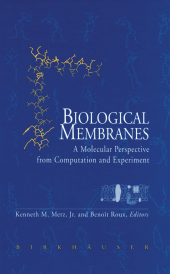 Neuerscheinungen 2012Stand: 2020-01-07 |
Schnellsuche
ISBN/Stichwort/Autor
|
Herderstraße 10
10625 Berlin
Tel.: 030 315 714 16
Fax 030 315 714 14
info@buchspektrum.de |

Kenneth M. Merz, Benoit Roux
(Beteiligte)
Biological Membranes
A Molecular Perspective from Computation and Experiment
Herausgegeben von Merz, Kenneth M.; Roux, Benoit
2012. 500 S. 116 SW-Abb., 2 Farbabb. 235 mm
Verlag/Jahr: SPRINGER, BERLIN; SPRINGER, BASEL 2012
ISBN: 1-468-48582-2 (1468485822)
Neue ISBN: 978-1-468-48582-0 (9781468485820)
Preis und Lieferzeit: Bitte klicken
The interface between a living cell and the surrounding world plays a critical role in numerous complex biological processes. Sperm/egg fusion, virus/cell fusion, exocytosis, endocytosis, and ion permeation are a few examples of processes involving membranes. In recent years, powerful tools such as X-ray crystal lography, electron microscopy, nuclear magnetic resonance, and infra-red and Raman spectroscopy have been developed to characterize the structure and dy namics of biomembranes. Despite this progress, many of the factors responsible for the function of biomembranes are still not well understood. The membrane is a very complicated supramolecular liquid-crystalline structure that is largely composed of lipids, forming a bilayer, to which proteins and other biomolecules are anchored. Often, the lipid bilayer environment is pictured as a hydropho bic structureless slab providing a thermodynamic driving force to partition the amino acids of a membrane protein according to their solubility. However, much of the molecular complexity of the phospholipid bilayer environment is ignored in such a simplified view. It is likely that the atomic details of the polar head group region and the transition from the bulk water to the hydrophobic core of the membrane are important. An understanding of the factors responsible for the function of biomembranes thus requires a better characterization at the molec ular level of how proteins interact with lipid molecules, of how lipids affect protein structure and of how lipid molecules might regulate protein function.
I: Computational Issues Regarding Biomembrane Simulation.- 1. Time Scales of Lipid Dynamics and Molecular Dynamics.- 2. An Empirical Potential Energy Function for Phospholipids: Criteria for Parameter Optimization and Applications.- 3. Statistical Mechanics and Monte Carlo Studies of Lipid Membranes.- 4. Strategic Issues in Molecular Dynamics Simulations of Membranes.- II: Experimental Probes of Biomembrane Structure and Dynamics.- 5. The Liquid-Crystallographic Structure of Fluid Lipid Bilayer Membranes.- 6. Infrared Spectroscopic Determination of Conformational Disorder and Microphase Separation in Phospholipid Acyl Chains.- 7. Membrane Structure and Dynamics Studied with NMR Spectroscopy.- III: Small Molecules and Peptides in Biomembranes.- 8. Movement of Small Molecules in Lipid Bilayers: Molecular Dynamics Simulation Studies.- 9. Structural Basis and Energetics of Peptide Membrane Interactions.- 10. Computational Refinement Through Solid State NMR and Energy Constraints of a Membrane Bound Polypeptide.- 11. Bilayer-Peptide Interactions.- IV: Membrane Proteins.- 12. Peripheral Membrane Proteins.- 13. Thermodynamics of the Interaction of Proteins with Lipid Membranes.- 14. Role of Lipid Organization and Dynamics for Membrane Functionality.- 15. Prediction of the Structure of an Integral Membrane Protein: The Light-Harvesting Complex II of Rhodospirillum molischianum.- 16. Monte Carlo Models of Spontaneous Insertion of Peptides into Lipid Membranes.- 17. Molecular Dynamics of Pf1 Coat Protein in a Phospholipid Bilayer.


